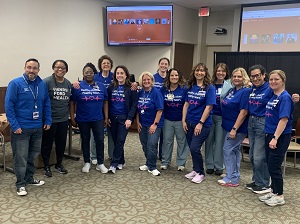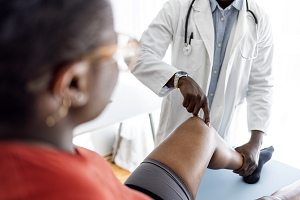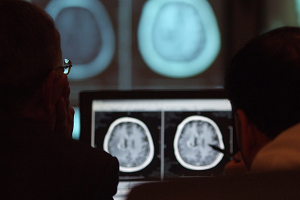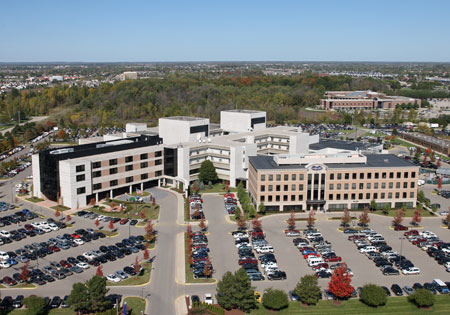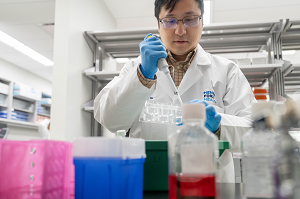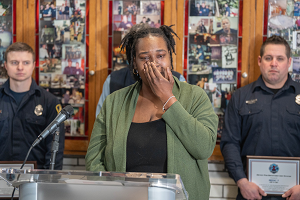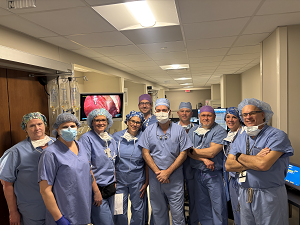Henry Ford Health System Cardiologists Perform 1000th TAVR Valve Replacement
FOR IMMEDIATE RELEASE
DETROIT – A Henry Ford Health System cardiology team performed the 1,000 TAVR heart valve replacement at Henry Ford Hospital.
The procedure, done exclusively through a catheter, was performed Tuesday, Dec. 19, 2017 by a team led by pioneering interventional cardiologist William W. O’Neill, M.D. and cardiothoracic surgeon Gaetano Paone, M.D. The hospital system is the first in metro Detroit and fewer than 20 in the United States to reach the milestone.
“We are honored to know we have helped so many people with advanced heart disease,” said Dr. O’Neill. Henry Ford Center for Structural Heart Disease cardiology fellow Tiberio Frisoli, M.D., and anesthesiologist Trevor Szymanski, M.D., also assisted with the 1000th TAVR.
The 90-year-old patient from Farmington Hills, Michigan, said he looks forward to walking his dog and travelling more with his wife.
Severe narrowing of his aortic valve had led to continual exhaustion for Jerry Licht, causing him to sleep much of the day. But after the procedure, Mr. Licht, who worked in the computer industry, said he felt energy return – and the sleepiness go away.
“My son said, “Dad, you have to sleep sometime,” Mr. Licht said from his bed a few hours after the procedure. He said the procedure also helped clear his head and return feeling to his fingers, which had been numb. “I feel good!”
TAVR provides a non-surgical alternative to valve replacement. The option is valuable for patients who have been told they are at increased risk for open heart surgery. The team inserts a long, thin, flexible tube into vessels in the groin, moving the tube through the vessels to access the heart. The new, artificial valve is collapsed on the end of a catheter. The catheter is then inserted into the tube, threaded into the heart and nestled in the diseased valve. Scaffolding holding the new valve is opened, pushing the old leaflets back. The new valve immediately begins opening and closing with each heartbeat to once again efficiently regulate blood flow through the heart.
Patients of the Center for Structural Heart Disease spend a day or two in new, private rooms at Henry Ford Hospital, which have been equipped with accommodations for an additional family member or friend. Most patients are well enough to go home quickly, and return to either the hospital or their own private cardiologist for follow-up.
The TAVR procedure is one of many highly specialist procedures offered through Henry Ford Health System. Cardiologist Adam Greenbaum has pioneered a number of procedures designed to increase access and safety of valve replacement for difficult cases, including the Transcaval Procedure for patients with small, hard-to-access vessels. Cardiologist and imaging specialist Dee Dee Wang, M.D., has established one of the largest and most active 3D printing programs in cardiology, designed to allow physicians to accurately plan, access and address patients’ cardiology needs. Henry Ford Hospital Catheterization Laboratory Director Khaldoon “Khal” Alaswad has achieved one of the highest success rates for Chronic Total Occlusion Percutaneous Coronary Intervention – breaking through heart vessel blockages while avoiding open heart surgery – in the United States.
“We strive to offer life-saving alternatives to patients who are told they have no options,” said cardiologist Henry Kim, Division Head of Cardiology at Henry Ford Hospital. “Many of our patients are relieved, after an initial exam or second opinion, that we offer the experience and know-how to help them.”
Dr. O’Neill is an internationally recognized leader in interventional cardiology and research in new techniques to diagnose and treat heart disease. He has been working on new catheter-based treatments of structural heart disease, and performed the first TAVR aortic valve replacement through a catheter in the U.S. in 2005. He also pioneered the use of angioplasty for treatment of heart attacks, which is now the mainstay therapy throughout the world.
Now, Dr. O’Neill is leading hospitals around the United States to treat patients in cardiogenic shock having a massive heart attack with a protocol that raises the survival rate from 50% to 76%. He is also one of 42 Master Fellows of the Society for Cardiovascular Angiography and Interventions, the international professional medical society for interventional cardiologists. Master Fellows make up less than 5% of the Society’s 4,500 members in 70 nations.
For more information on cardiology options available at Henry Ford Health System, visit www.henryford.com/hvi. For information on TAVR, please visit http://bit.ly/2CPlwza or call 844-725-6424.
MEDIA CONTACT:
Tammy Battaglia
TBattag1@hfhs.org
2148-881-0809
.svg?iar=0&hash=F6049510E33E4E6D8196C26CCC0A64A4)

/hfh-logo-main--white.svg?iar=0&hash=ED491CBFADFB7670FAE94559C98D7798)

